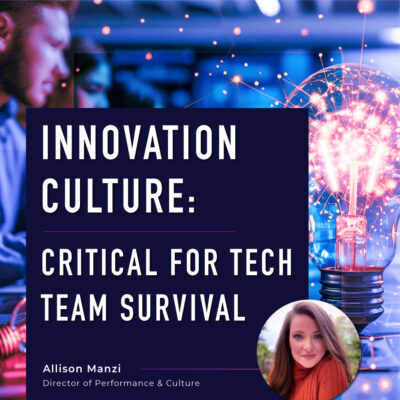Innovation Culture: Critical for Tech Team Survival
July 8, 2024

Today’s Tech industry is moving at light speed and evolving faster than ever before. With new products, software, and intelligent software turning up each day, tech companies are racing the clock to constantly innovate and continue to put out cutting edge products before their competitors. Running at a sprint, any small stumble can kill the throttle, and missing out on even one visionary idea or original take can pull a business out of the race. So how do fast-paced companies stay at the forefront of progress? They create a culture that elicits innovation and inspires creative practice.
So, what does that kind of environment look like? How does it function? How can we graduate from simply saying we “prioritize innovation” to a practical application of those supportive behaviors that cultivate that type of culture? I’ll give you six researched-backed steps we took [at Edison] to increase our “space to innovate” score, company-wide.
1 | Psychology Safety
This is the most critical element for encouraging new ideas. Every single person on the team must feel comfortable sharing their suggestions without the fear of criticism, rejection, mockery, or dismissal from peers and leaders. Of course that doesn’t mean every single idea needs to be applied, but it does need to be acknowledged with respect and validation for its attempt. Leaders must be mindful of an overbearing influence that leaves no room for collaboration, encourages assimilation, or intimidates others too much to share. In group settings, leaders and strong voices should speak last, if at all, and every person should be prompted to contribute thoughts individually. All ideas should be received with neutrality and without an immediate “yay or nay” on the spot so that team members can speak without the innate fear of rejection.
2 | Autonomy
Freedom, baby! Employees should be able to split up their work (within reason) according to the schedule that works for them. Maybe they’re most productive from 2p-10p, but drag in the morning. Perhaps they need a walking break to improve flow. If they have a great idea mid-day, they need to be able to pause their current project to jot down thoughts. Micromanaging a forced workflow is a surefire way to stunt creative thoughts and stifle bright ideas.
3 | Quality-Based Metrics
The way an organization measures success can have a huge impact on how employees work, where they spend their time, and what they prioritize. Of course, certain roles (like sales) are more focused on quantity–but consider which team members are responsible for innovation and normalize placing importance on the quality of their output rather than cranking out a high volume of lackluster deliverables quickly, or just racking up hours at the computer. Make it clear that fewer ideas or products of higher quality–this will permit them to spend more time on the creative process to fully develop and refine their ideas. We often award those who just work the most, but a shift towards celebrating good ideas and out-of-the-box approaches can inspire quality-focused work.
4 | Meaningful Impact
A clear “why” is an important driver for the right kind of creative ideas that hit a homerun. Make sure employees are well connected to the problem your company, or product, is looking to solve, and how it aims to improve the lives of their customers (not just the business goal or product features!). The impact should be talked about in-depth, and often. A clear destination makes it easier to reverse engineer the path to get there. Plus, adding that human element of purpose allows employees to empathize with the experience of the consumer and come up with more succinct ideas based on their own experience.
5 | Anti-Burnout Culture
When employees are burnt out over over-stressed, their nervous system is likely to be in fight-or-flight. When the body (and subsequently, the brain) are in this red-alert state, there is an extremely narrow focus on basic needs (ie sleep, food, rest) and innovation is out of the picture. In this dysregulated state, specific areas of the brain (like the prefrontal cortex) that are responsible for comprehensive ideas and imagination are shut down. Keeping a culture that normalizes taking rest, days off, closing the computer at 5pm, and prioritizing mental health will encourage innovation.
6 | Dedicated Time
Creating new ideas and projects will be a last priority when there’s always a to-do list a mile long. Setting aside specific time slots–where the only function is generating new ideas–can relieve the pressure and guilt of pausing current work. This could be as little as an hour every other week. The boundaries of this time period have to remain strong and facilitators should “require” creative practices and nothing else.
The priority elements in an innovative culture are safety, meaning, and fluidity. If your team can incorporate these practices, you will encourage new ideas and creative solutions on a daily basis. And remember, a culture is not built by simply saying–or even writing down–these ideal values. It’s built by normalizing habits and behaviors and is demonstrated by leaders, so be sure to practice what you preach and watch your team soar!
Written by: Allison Manzi, Director of Performance & Culture